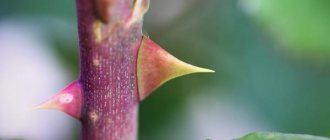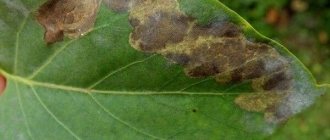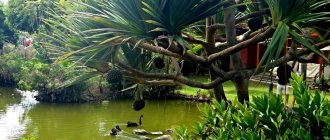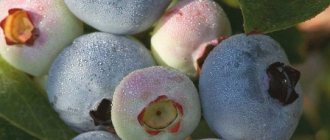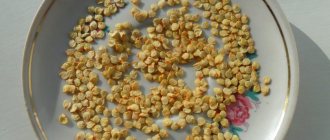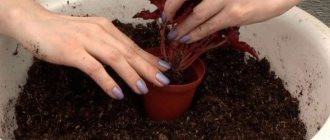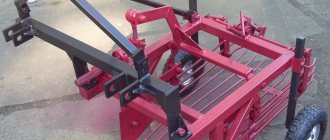Kruknek is a word alien to the Russian ear, but its translation “curved, twisted neck” immediately explains why this vegetable is called that. The oblong-rounded fruit ends with a smaller diameter, but such a well-curved hook that the crop can be hung for storage.
Closely related to zucchini and squash, kruknek is similar to both vegetables. The plant itself and the growing technology also resemble these crops. Leaves, vines, flowering - until the characteristic curvature of the fruit appears, you can’t always figure out what exactly is growing. That’s why gardeners nicknamed the hooked vegetable “pumpkin-squash crookneck.” In fact, this name is justified, because the Cucurbita pepo family, which includes all these crops, directly translated from Latin contains the word “pumpkins”.
Kruknek: description
Kruknek
The closest relative of zucchini and pumpkins, “crookneck,” as our summer residents affectionately call cruknek, at first gives the impression of a sick fruit:
- the “neck” is twice as narrow as the “body” - a feeling that the vegetable is drying out on one side;
- Twistedness also does not seem to everyone a sign of a healthy fetus;
- The pimpled appearance of mature crukneks resembles warts or internal blisters, which a gardener accustomed to the smooth sides of zucchinis associates with infection or pest damage.
But no, it’s so crooked and lumpy on the outside, but very healthy and nutritious on the inside, and those who have already become acquainted with the culture need kruknek. But it is not grown so often yet.
If a crookneck bush cannot be distinguished from a pumpkin or squash bush, then the fruits certainly cannot be confused:
- They begin to bend immediately after the formation of the ovary.
- Color - from rich yellow to deep orange.
- By the end of the season, the stalk is so hard that sometimes a hacksaw is needed, and sometimes the fruit is cleaned with a hatchet.
- Weight is up to one and a half kilograms, but more often they are removed before the obvious appearance of tuberosity, when the skin is still soft. Such fruits weigh 0.4-0.5 kg.
Soft and tender, but denser than that of zucchini, the flesh of kruknek is eaten fresh - in vegetable salads. Suitable for drying, pickling, frying. Crooknecks are stewed, stuffed and dried. And the seeds are not inferior in taste and benefits to pumpkin seeds.
Crooknecks that have been allowed to mature until autumn often compete with decorative pumpkins. Or used in joint compositions for country style decor. They are stored for more than six months, emitting solar heat in winter.
Krukneks are given due attention in their homeland - in Central America and East Asian countries, where the climate is ideal for an annual plant. After all, all representatives of pumpkin plants cannot tolerate cold weather at all. Even short-term frosts will destroy the plant.
The unsightly-looking fruits are considered more nutritious and healthier than zucchini. In the fight against excess weight, atherosclerosis, cholesterol and high sugar, krukneks are simply irreplaceable. It is unlikely that the torticollis will ever displace squash and zucchini from vegetable gardens, but it will definitely take its rightful place.
Crookneck varieties
Although the unusual type of vegetable is not so popular, there are also already beloved varieties of crookneck.
| Name | Ripening time (days) | Fetus |
| Seneca | Early – up to 50 | The shape resembles a jug, smooth, yellow, glossy. About 10 pieces per bush. |
| Giant | Early – 45-50 | 8-10 pear-shaped fruits, very pimply, bright yellow. |
| Giraffe | Early – up to 45 | The kilogram-long yellow-orange club-shaped fruits are rich in vitamin A and ascorbic acid. |
| Scrooge | Average – 55 | Bright orange color, club shape, tuberculate, 600-700 g |
| Golden comb | Average – 55-60 | The largest, up to 2 kg, fruits |
| Summer | Average – 60-70 | Orange, smooth, 0.4 kg |
More often than other varieties in gardens among pumpkins and zucchini, the Scrooge crookneck is found. Gardeners fell in love with it for its sweetish, nutty-tasting pulp. But for this purpose, the fruits are not kept on the bush for more than two weeks. Then they are cooked without even removing the skin.
Crooknek Giraffe
Kruknek Golden scallop
Crookneck Scrooge
Beneficial features
What's so special about crookneck scrooge? Firstly, it is very productive, and secondly, it can be eaten raw. The raw pulp of the young plant is sweetish with a nutty flavor. With scrooge you can make salads and various homemade preparations. It is recommended to use it in dietary and therapeutic nutrition for cardiovascular diseases and chronic diseases of the gastrointestinal tract.
Skilled housewives cook, stew, marinate, salt, and preserve cruknek fruits. Vegetable soups are cooked with krukneks, stuffed with meat or vegetables, steamed, frozen, caviar is made, and krukneks are fried in dough.
As medicinal vegetables, crooknecks are useful for patients with atherosclerosis, coronary heart disease, metabolic disorders, and those who are overweight. As already mentioned, they are recommended for cardiovascular diseases, anemia, chronic diseases of the gastrointestinal tract and kidneys. Due to their low calorie content, the fruits are perfect for the diet menu.
Growing seedlings
To get tasty and healthy vegetables early, summer residents prefer growing crukneks using seedlings. Since the crop does not tolerate the slightest cold snap, kruknek seeds are planted in peat or plastic pots so that the bushes have no more than 20-25 days before stable warmth:
- In the south, by the end of April there will definitely be no frosts, so from the last days of March you can already sow.
- In the central zone, they are planted without fear after the May holidays, which means that in April, in the second half of the month, the seeds are lowered into the planting soil.
- In Siberia, it is risky to plant seedlings of heat-loving crooknecks before the first ten days of June, so planting at home is in May.
The usual pre-sowing preparation - soaking in potassium permanganate for half an hour - will speed up germination and strengthen the crookneck's immunity. Pumpkins sprout quickly, within a week. If the planting mixture was initially prepared with a rich supply of nutrition, then the plants are not fed before transplanting. Heat, light, moderate soil moisture with warm water - everything that is necessary for strong seedlings.
Crooknecks planted in peat or coconut, after the first full leaf, are given, according to dosages for seedlings, complex fertilizer or fed according to the recipes of the folk menu - yeast, ash.
Preparing seedlings and soil
Growing Kruknek seedlings
Before planting, Kruknek bushes are kept for several days on an open window or balcony for hardening. Meanwhile, in the garden, the soil is being prepared for seedlings:
- dig up with the addition of a large amount of organic matter (crooknecks love fertile soil);
- water with warm water;
- cover with film so that the earth retains moisture and warms up.
Having chosen a good day, the bushes are planted in the same way as zucchini or pumpkins. The best time is evening. The ground around the stem is mulched with compost, straw or rotted sawdust.
During the first days, depending on the weather, crooknecks need:
- protection from cold – film or covering on the arches;
- shelter from the scorching sun - shading with a canopy made of thin white agrotextile or huts made of newspapers.
If the place for crooknecks is chosen well and the ground is prepared correctly, the gardener will soon see flowers, and then it won’t be long before fruits appear.
Selecting a location, soil requirements
The main requirement of crank necks for the place of cultivation is sun. If the site is illuminated for 5-6 hours a day, the culture will be comfortable. But the plants do not like the sun. Therefore, it is good if it is before or after the midday heat. The gardener is interested in proper lighting of the area: in hot weather, under direct rays, the air becomes hot, and in such conditions the crookneck produces only male flowers. But they don't bear fruit.
Outlandish vegetables do not need to be dedicated to a whole garden bed. Several spot-planted bushes in different places - along the edges of a potato field, along the southern fence - will provide the summer resident with the required amount of fruit. It is more important that the following requirements are met:
- Composition of the earth. The ideal option is black soil or loam. The crop does not tolerate heavy soil, and sandy soils do not have enough nutritional value and moisture. If it is not possible to prepare a large volume of land (a bed), it is easier to organize separate planting sites for each bush. Soil is placed in a trimmed barrel or high bed, with plenty of organic matter mixed in. Clay soils are diluted with sand and peat.
- Acidity. The best option is a neutral reaction. When planning to plant crooknecks on acidic soil, dolomite flour and lime are dug in in the fall. There are other ready-made preparations - deoxidizers. Coniferous litter and lowland peat are added to alkalized soils before winter.
- Groundwater. Although crooknecks love humidity, they will die in damp conditions. The only inexpensive way is to plant in high beds.
- Crop rotation. The crop is planted where cabbage, beans or peas and beans, salad greens, tomatoes, and potatoes were grown in the previous season. Crookneks are comfortable after onions and garlic, carrots or beets.
Important! Bisexual flowers pollinate well not only on one bush, but also with nearby growing zucchini, pumpkins, and squash. Therefore, crooknecks are planted away from related crops.
Planting in open ground
It is difficult for Siberians to grow crukneks without seedlings. And in the middle zone, and even more so in the south, the climate allows planting seeds in open ground. Having prepared the ground in the fall, in the spring the gardener will only arrange the planting places - individual or in the garden bed. If you don’t have enough time in the fall, then a couple of weeks before sowing you need to:
- dig up the ground, removing weeds, roots, debris;
- add half a bucket of compost or rotted manure to each planting site;
- Mix the fertilizer with the soil and level it.
Important! A few days before sowing, the prepared soil is spilled with warm water and covered with black film. The opaque material will not let weeds through, and the soil will warm up well.
Planting dates for Kruknek zucchini
The seeds are placed in warm soil when no frost is expected. The soil temperature is not lower than 13-15 during the day - conditions for the germination of crookneck.
The approximate sowing dates correspond to the time of planting. But in each specific season, summer residents take into account weather forecasters so as not to be left without a harvest.
Planting crookneck in the ground
The earth has warmed up, the weather has become warm - it’s time to sow. There is no need to fertilize the soil that is already charged with nutrition.
Seeds pickled in potassium permanganate or fungicide are placed in a hole up to 3-4 cm deep, covered, lightly pressed down and watered. Each bush is given an area of at least 70x70 cm.
Before germination, the planting site can be covered with a transparent film: in greenhouse conditions, crooknecks will sprout faster. Another option is to cover the planting site with a cut-off 5-liter plastic bottle. When the plant hatches, remove the lid from the container and leave the bush under cover for a week and a half.
Disease and pest control of crookneck
The most common crookneck disease is powdery mildew. Its sign is a whitish coating on the leaves. To prevent it, you need to water the plants only with settled warm water. During fertilizing, I increase the dose of potassium fertilizers, especially during the period of massive fruit ripening.
If the disease does appear, reduce the number of waterings and be sure to remove and destroy all ovaries affected by powdery mildew.
The first harvest of torticollis fruits occurs at the end of June. I would like to note that in terms of nutritional value and richness of the chemical composition, krukneks are noticeably superior to their closest counterparts.
Caring for the Kruknek plant
Kruknek: growing in open ground
A rapidly growing crop that requires nutrition and watering. At least three feedings per month - plant fertilization schedule. Use infusions of mullein or dung. But excess nitrogen will affect the growing season: the bush will begin to fatten to the detriment of fruit set. Therefore, they alternate with herbal infusion and ash solution.
Gardeners who use mineral fertilizers feed the complexes in half the dose of the proportions specified in the instructions.
For irrigation, water is poured into containers in advance so that cold moisture from the well does not destroy the roots. Crooknecks are water feeders; in hot weather they are watered more often and more abundantly. Up to two times a day - morning and evening. As soon as the leaf plate has hung its edges, the summer resident knows: it’s time to take the watering can. Mulch laid in a thick layer around the stem will help reduce watering (and the number of weeds).
The bushes do not produce long vines, so there is no need to pinch the shoots. The only intervention of the gardener in the formation of plants is required if abundant flowering does not produce ovaries - male flowers predominate. In these cases, the growth of the bush is limited upward so that side shoots appear. They have more female flowers.
If the summer turns out to be unsuccessful - cold, rainy - crooknecks do not set fruit well. In such seasons, two measures will help:
- A film is stretched over the bushes to protect from cold and excess moisture.
- They help the plant with brush pollination.
In general, agricultural technology is similar to growing zucchini. For an experienced gardener, a new crop will not cause any trouble, and a beginner will not find it difficult.
Kruknek - how to grow and cook a miracle vegetable
Are you not growing crookneck in your garden yet? Have you never even heard of it and don’t know what it is? Then our article is just for you. From it you will learn:
• What is crookneck? • Description of kruknek • Distribution area • Planting kruknek in open ground and growing through seedlings • Caring for kruknek • Harvesting and storing crops • Diseases and pests • Useful properties of kruknek • Varieties • Culinary recipes
What is crookneck?
Kruknek is a vegetable that some call zucchini and others call pumpkin. Both are right, because kruknek, like zucchini, is one of the forms of the pumpkin species (Cucurbita pepo). Representatives of this species are conventionally divided into two groups.
The first includes crops that quickly, in two months or a little more, ripen to consumer readiness, for example, zucchini, zucchini, and squash. They are eaten at the stage of milky ripeness, when their skin is tender, their size is small, and the seeds are just beginning to form. The peak of their consumption is summer. These summer squashes are called zucchini.
The second group includes pumpkins that require a long period of ripening and are eaten only when fully ripe. They have a hard crust and mature seeds. Such pumpkins last for several months, until spring, which is why they are called winter pumpkins.
In terms of its physiological and consumer qualities, kruknek is more related to zucchini. Its Latin name in scientific classification is Cucurbita pepo var. torticollia. If the kruknek is left to ripen, it can easily pass for a decorative pumpkin - it has such a bright and exotic appearance. The main visual difference of the crookneck is the crooked fruit, which is why it was given the name “crookneck”, because from English “Croocked Neck” literally translates as “crooked neck”. The skin of the crookneck is yellow and lumpy, as if covered with swollen blisters or warts. Those who see the fruits of this miracle vegetable for the first time may mistake them for unripe pumpkins or zucchini that have been affected by some kind of “sore”. But the crookneck is only unsightly in appearance. Inside it is a real treasure trove of useful substances and vitamins, which in total are superior in nutritional value to zucchini. Kruknek is very tasty in itself, but its main value is that it can be used as a medicinal product for many diseases. In addition, the ripened vegetable is very decorative and can decorate the interior for many months on its own or as part of a composition.
Description of crookneck
Kruknek is an annual plant that forms a lush, spreading bush (like bush squash) up to 70 cm high. Climbing varieties of cruknek are less common. The vegetable has a powerful taproot, highly branched root and medium-sized leaves, the shape of which can be five-lobed or heart-shaped.
The flowers of this plant are similar to pumpkin and squash. They are yellow, large, single. Both male and female flowers can bloom on the same bush, but cruknek is well pollinated by insects not only with its fellows, but also with related squashes, pumpkins, and zucchini. This must be taken into account when choosing a landing site. Kruknek fruits are usually twisted. They can be pear-shaped, club-shaped, or simply curved. The bend is almost always observed close to the peduncle. In this place, the fruit seems to be stretched and divided into two parts: narrow - closer to the peduncle, and thicker - at the floral end. The color of the skin of ripe fruits can range from white to yellow and bright orange. The inside of the kruknek is mostly yellow-orange, but can be beige or cream. Its pulp is tender, pleasant to the taste, and practically free of fibrous components. The peel of the vegetable can be smooth, warty or lumpy. The seeds are similar to squash, but somewhat smaller.
►Mexican cucumber (chayote) ►Mad cucumber ►Growing squash
Crooknecks are eaten unripe, until a bump begins to form on their skin. The younger the fruit, the tastier it is. For most varieties, consumer ripeness occurs when their length is 10, maximum 15 cm, and their diameter is no more than 6 cm. But there are larger-fruited cruknecks. Their skin does not harden for a long time, and the seeds form late. The weight of ripe fruits of such varieties can reach more than 1 kg.
As kruknek ripens, the flavor deteriorates, its size increases, and the skin becomes rough enough that it can be difficult to peel with a regular knife. Ripe fruits can be stored for up to eight months, and thanks to their bright and unusual appearance, they can be used for decorative purposes, like decorative pumpkins. Just like pumpkin or squash, kruknek can be left to ripen seeds (unless it is a variety labeled F1, that is, a hybrid). Seeds remain viable for at least 5 years.
Distribution area
Kruknek is native to Central America, where it is successfully grown in mountainous regions. It is cultivated in the USA, East Asia, Canada and Europe. The planting area in open ground is limited by climatic conditions, since crookneck does not tolerate frost at all. A drop in temperature below zero, even by 1 degree, can destroy a plant left without reliable shelter. However, the short period from sowing to harvesting (from 2 months), the use of seedlings and shelters makes it possible to grow kruknek in many agricultural zones.
Crookneck planting
Crookneck is no more difficult to grow than zucchini
or
pumpkin
. It can be planted in open ground (either seedlings or seeds) only when there is 100% confidence that there will be no return frosts. In each region of Russia, suitable weather is established at its own time. For the middle zone this is the end of May - beginning of June.
You need to choose a sunny place for planting, away from other pumpkin plants, to avoid cross-pollination. The plant should be in the open sun for at least six hours a day, but the scorching midday rays are also not very undesirable for it.
Kruknek requires light, breathable, fertile soil to be provided in the garden. The best soils will be loamy soils with a pH between 5.8 and 6.8. The site for future planting is first dug up, the soil is broken up with a rake, and organic matter is added. This is done in the fall, and in the spring they dig up again and apply nitrogen fertilizer and potassium sulfate (at the rate of 29 g per 1 m2), or apply a full range of mineral fertilizers according to the instructions on the package, usually 30-40 g per m2.
Kruknek can be planted from seeds. In this case, they are pre-soaked in a slightly pink solution of potassium permanganate for 30 minutes (if they are not treated with a fungicide upon sale). When sowing in open ground, it is necessary to take into account that seeds germinate at a temperature of + 23-28 degrees. Therefore, the soil in the garden bed must be warmed up. For this purpose, about a week before planting, it is covered with black plastic film.
It is more convenient to place plant seeds in holes, deepening them into the ground by 3-4 cm. The distance between holes should be maintained at least 70-80 cm. You can also sow in rows, the distance between which should be about 90 cm, and between seeds - from 50 cm. Kruknek grows very well when planted in the center of a small mound - this is the third planting option. After sowing, it is advisable to cover the bed with agrofibre.
Growing crookneck from seedlings
To get an early harvest, kruknek is planted as seedlings. It is grown in the classical way. The seeds are placed in peat pots filled with soil for seedlings. You can prepare it yourself from garden soil, to which humus and mineral fertilizers have been added. The timing of planting seeds for seedlings may vary, depending on when in your region it will be possible to plant kruknek in open ground. Like all pumpkins, it sprouts and grows quickly. Therefore, do not rush with sowing, otherwise your seedlings will have time to “mature” a lot before moving them into open ground and will not take root well. It is optimal when there are 2-3 real full-fledged sheets on it. Kruknek can reach this phase within 3-4 weeks after germination.
Seedlings are planted in the evening when the heat subsides. At first, young shoots are covered with film or spunbond overnight. This must be done, since the temperature conditions at home and outside are different. The plant needs to adapt to its new location.
Experienced gardeners believe that kruknek planted with seeds is stronger than its counterpart, which began its life on the windowsill. The second one begins to bear fruit a little earlier, but the first one soon catches up with it. The best option is to plant several plants as seedlings, and sow a few in open ground. This will take longer to harvest.
Caring for crooknecks in open ground
Kruknek grows quickly, so it is demanding on watering and nutrition; without water it bears fruit worse. You need to water the plant with warm water, and to keep the moisture in the soil longer, it needs to be mulched. Mulch will also protect against weeds. As the leaves grow, the need for mulch may disappear, since the leaves will create a reliable shadow in the root area.
If you have a well on your property, you cannot use water directly from it for crooknecks. It is better to pour it into buckets and let it sit in the sun.
If heat begins in your region, the overseas vegetable will not wither, but will begin to produce only male flowers. To preserve fruiting, plants need to be protected from direct sunlight. It must have good ventilation. During the day, you can water the shelter generously to lower the temperature. The optimal mode for crooknecks is +25°C plus/minus 1-2°C.
If there is a cold snap with persistent cloudy or rainy weather, the crookneck will refuse to form ovaries. Its leaves will turn pale. You can try to get out of the situation by installing a greenhouse over it, and in this way endure the vagaries of nature.
Crooknek requires feeding throughout the entire growing season. Experienced gardeners fertilize it every 10 days with mullein diluted with water in a ratio of 1:5. You can also use slurry, but from an excess of nitrogen the plant may begin to “fatten” to the detriment of fruit formation. The situation can be corrected by adding ash.
Fertilizing with diluted complex fertilizer, where all components are balanced, has a good effect. It is used once every 10 days, using a dosage half as much as indicated in the instructions. Also, throughout the growing season, you must remove drying crookneck leaves (usually the lower ones) and fruits that have begun to rot, shallowly loosen and hill up the bushes.
If your overseas vegetable suddenly begins to produce only male flowers, but the weather is acceptable for it, try removing the apical buds. Then the crookneck will be forced to form side shoots, on which female flowers usually develop.
Harvesting and storage
It is advisable to collect the fruits when they reach a length of 10-13 cm. In this case, the pulp will be more tender and tasty. The harvest is often picked so that the fruits do not become overripe. To make the plant less stressed, it is better to do this early in the morning or late in the evening. The crookneck, together with part of the peduncle, is cut off with a knife or unscrewed by hand. Store vegetables on open shelves, but not in the refrigerator. For cooking, young fruits do not need to be cleaned; just wash them with water.
Diseases and pests
Kruknek is almost not susceptible to plant diseases that prevail in Russia. It can only suffer from downy mildew
.
Prevention in this case is proper care, which consists of moderate watering, and only with warm water. If the plant does get sick, you need to remove all the spoiled fruits and treat the leaves with Bordeaux mixture (1%). You can try using folk remedies. Gardeners advise spraying plants with a thick solution of potassium permanganate or iodine. This should be done in a day or two. You can spray the entire plant with kefir, slightly diluted with water (so that you can use the sprayer). Of the pests for crookneck, the most dangerous is aphid. These small insects settle on the underside of the leaves, causing them to begin to curl. The plant not only loses its aesthetic appearance, but also stops bearing fruit and soon dies. At the first sign of aphids, you should immediately treat the crookneck with an appropriate insecticide
.
You can also use traditional methods
, which help a lot in this case. The most effective of them is an infusion of ash (a glass of 5 liters of water, leave for 12 hours). Some people recommend using a soap solution. To quickly rid the crookneck of its scourge, you need to add an adhesive to the solution.
Ants transfer aphids to plants
. Therefore, a preventative measure against these pests is to clear the beds of anthills. By the way, these insects often dig out their passages right between the roots of an overseas vegetable.
Useful properties of kruknek
Kruknek can with a clear conscience be called a medicinal plant, and its unripe fruits are the most valuable dietary product. They contain: • Vitamins A and C. • Thiamine (vit. B1). • Riboflavin (vit. B2). • Folic acid (vit. B9). • Pyridoxine (vit. B6). • Niacin. • Phosphorus. • Calcium. • Magnesium. • Iron. • Zinc. • Manganese. • Potassium. • Copper.
Kruknek is very low in saturated acids, sodium and cholesterol. This rich chemical composition determines the beneficial properties of the miracle vegetable. It helps with the following diseases and conditions: • Atherosclerosis. • Anemia. • Diseases of the gastrointestinal tract. • Kidney failure. • Nervous diseases. • Heart failure. • Diseases of blood vessels.
When consumed regularly, kruknek stabilizes metabolism, helps slow down the aging process, improves the condition of hair and skin, and helps get rid of excess weight.
Varieties
Currently, there are not many varieties of this vegetable on the Russian market. Of those presented, the majority are the result of foreign selection. Among the early ripening ones there are the following: • Shell.
•
Early golden.
•
Giant
.
Mid-season varieties include: • Castlegold
.
• Castlex 4004
.
Scrooge is popular among Russian gardeners.
. It takes 50-55 days from the moment of sprouting to harvesting. Its fruits are club-shaped, bright orange, tuberculate, weighing up to 700 grams. The fruits can be stored until January.
Another popular variety is Giraffe
. This crookneck requires only 40-45 days from germination to harvesting the first fruits. Its fruits are yellow-orange, club-shaped, with a warty skin. Their weight can reach 1 kg. The pulp of this variety contains a lot of vitamins C and A.
Crookneck squash Golden scallop
ripens in 60 days, and its fruits reach a weight of one and a half to two kilograms.
In the mid-season variety (60-70 days) Summer
, with orange fruits weighing 300 g or a little more, the yield of one bush is 3.2 kg.
Recipes with kruknek
The overseas miracle vegetable is used in salads, it is suitable for frying, stewing, stuffing, boiling, canning and pickling. In addition, it stores well. Even in January-February you can treat your loved ones with dishes made from it. We offer several simple recipes.
Kruknek with rice
You need to take
: • 1/3 cup rice.
• 1 medium onion. • Vegetable oil. • 1 crookneck weighing about 700 grams. • Greens, salt. How to cook
: peel the vegetable, cut into small cubes and fry in a frying pan. Boil the rice until half cooked. Cut the onion into cubes and also fry in oil until golden brown. Place the kruknek, rice, onion, and finely chopped greens into a deep frying pan. Add 2 cups of water, add salt and simmer until done.
Kruknek salad
You will need
: • Kruknek fruits (the quantity depends on how many servings you are preparing the dish for).
• Parsley. • Dill. • Vegetable oil. • Vinegar. • Salt. How to cook:
peel the kruknek and grate it on a coarse grater. Chop the greens. Place the prepared vegetables and herbs in a bowl, season with vegetable oil, sprinkle with vinegar, and salt.
Krukneck croquettes
For the dish you need to prepare
b: • Kruknek fruits (500 grams).
• 2 eggs. • Flour (about 2 tablespoons, depending on how much the mixture takes in). • Hard cheese (50 grams). • One small onion. • Salt pepper. • Vegetable oil. How to cook
: peel the kruknek, grate it on a fine grater, add salt and set aside for 10 minutes. Peel the onion and also grate it on a fine grater or chop it in a blender. Cut the cheese into squares and also grind in a blender.
Squeeze the resulting liquid from the salted kruknek. Add eggs, cheese, pepper to the remaining mixture, mix thoroughly. The mass should be thicker than for a pancake, but not tight. To achieve the desired consistency, add flour a little at a time, mixing thoroughly. Roll the resulting mass into balls.
►Zucchini preparations ►Pumpkin dishes
Pour oil into a deep metal bowl. There should be enough of it so that the balls can float freely in it. Heat the oil. Next, place the prepared balls into it one by one. There is no need to roll them in flour. They will immediately sink, and when ready to rise to the surface. They should be immediately removed and placed on a plate lined with paper napkins to remove excess oil. Croquettes are best eaten hot, before the cheese in them hardens. The dish is incredibly tasty, liked by both adults and children.
Kruknek with potatoes
To prepare this hearty and tasty dish you need to take
b: • 2-3 medium potatoes.
• Medium bulb. • Vegetable oil. • 1 crookneck weighing about 500 grams. • Salt, pepper, herbs. How to cook
: Wash and peel the potatoes, cut into strips and fry in a frying pan. Also peel the kruknek, cut into cubes, and fry separately from the potatoes. Place everything together in one frying pan, add finely chopped onion, vegetable oil, salt and pepper. Bring over low heat until done. Before serving, sprinkle with finely chopped herbs.
► Recipes with squash ► How to grow delicious turnips
Canned kruknek
You will need
several fruits at the stage of ripeness, but without hard seeds inside.
For preservation you will need for a 1 liter jar: • 2-3 small crooknecks. • 20 g dill. • 6 cloves of garlic. • Hot pepper (to taste). For the marinade: • 500 ml water. • 40 g salt. • 60 ml vinegar. How to cook
. Wash the kruknek thoroughly, cut into circles and put in a jar. Add garlic, pepper, dill. Pour over the marinade. Sterilize for 10 minutes. If you can preserve in three-liter jars, they need to be sterilized for 15 minutes.
►Pumpkin vegetable crops
► Recipes for winter
“Site about plants”, www.pro-rasteniya.ru
Return to section
If you liked the article, please share the link on your social network! Thank you!
| < Previous | Next > |
